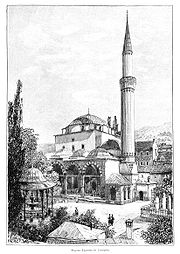Gazi Husrev Bey
Gazi Husrev-beg | |
|---|---|
 | |
| Native name | Ḫusrev |
| Born | 1484 Serres, Ottoman Empire (modern-day Greece) |
| Died | 1541 Mokro, Ottoman Empire (modern-day Montenegro) |
| Buried | |
| Allegiance | |
| Years of service | –1541 |
| Rank | Sanjak-bey of Bosnia and Smederevo |
| Battles/wars |
|

Sultanzade Gazi Husrev-beg (
Biography
Origin
Gazi Husrev-beg was born in
Career

In less than three years, he conquered the fortresses of Knin, Skradin and Ostrovica. He was appointed sanjak-bey of the Sanjak of Bosnia on 15 September 1521, becoming one of Sultan Suleiman I's most trusted men.
A relentless campaign of conquest followed soon; the fortified towns of Greben, Sokol, Jezero,
He founded, among the many buildings he ordered to construct in the city, the vakuf of Sarajevo, which was active until the 20th century.[3]
Gazi Husrev-beg played a crucial role to overcome the Christian army at the Battle of Mohács. His 10,000 Akıncıs and his irregular cavalry, composed of Turks, Bosnians and Crimean Tatars, served as reserve soldiers in that battle. According to the Ottoman military strategy, the Akıncıs circled the European knights while the Turkish infantry made a counterfeit retreat after the first assault.
Death
Gazi Husrev-beg's forces struggled against a power vacuum in
Endowment
Gazi Husrev-beg's endowment or Gazi Husrev-begov
The endowment today consists of a number of buildings and institutions built and supported by the Gazi Husrev-begov Vakuf: the
The Museum of Gazi Husrev Beg is established in fall 2012 by the Gazi Husrev Beg Waqf (endowment).[4][5]
Most of these building are declared
See also
References
- ISBN 9789958626135.
- ISBN 9789958626135.
- ISBN 0-333-66215-6.
- ^ "Historija". Gazi Husrev-begov vakuf (in Bosnian). Retrieved 11 January 2022.
- ^ "Vakif". medresasa.edu.ba (in Bosnian). Retrieved 11 January 2022.
Sources
- Yugoslav Encyclopedia, article Husrev Beg, vol. IV, Hazim Sabanovič, Zagreb 1960
- GAMER, I, 1 (2012) s. 99-111, The other Ottoman Serhat in Europe: Ottoman territorial expansion in Bosnia and Croatia in first half of 16th century, Dino Mujadžević
